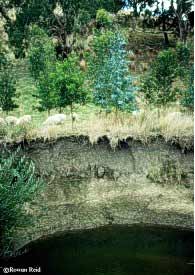|
Buffer Strips for Nutrient Trapping

Research has shown that seasonal flowing drainage
lines and small creeks contribute the bulk of the nutrients
to a river system. Buffer strips of grass and trees along
these drainage lines and waterways can prevent some of the
nutrients leaving pastures and croplands. On grazed land the
exclusion of stock from the waterways is a another simple
and effective strategy. While this may mean additional off-stream
watering points are required, it may also make mustering easier
and overcome the risk of losing stock, which may become trapped
in mud.
Nutrients may travel in overland flow (runoff) either in solution
(dissolved) or attached to soil particles. Sediments are best
trapped by dense ground covers such as grass. Deep leaf litter
layers are useful but are at risk of being washed into the
waterway as well. It is therefore important to allow a thick
sward of grass or other ground covers to develop under or
beside trees. A dense planting of eucalypts will lead to bare
ground and should be avoided.
The effective width of a buffer strip depends on the volume
and rate of overland flow. Since the land close to drainage
lines is often the most productive, it is impractical to expect
farmers to fence off wide belts along all their drainage lines.
A simple survey of the banks will identify low-lying points
where overland or sub-surface flow is likely to occur. These
areas would require much wider belts than banks that are high
and stable. The temptation to adopt a minimum width should
be avoided, as it will clearly be insufficient in some areas
and unacceptable to farmers in others.
In order to harvest the nutrients trapped in the buffer strips,
whole tree removal and grazing may be required. Simply ‘locking’
up the area may ultimately lead to the buffer strip being
ineffective as a nutrient trap because of nutrient saturation.
Wetlands and pools in seasonal drainage lines are ideal nutrient
traps for harvesting soluble nitrogen. Water plants and trees
growing around the ponds can use the nitrogen for growth.
Again, harvesting in some form is required to extract the
nutrients from the site.
Back to top
|
